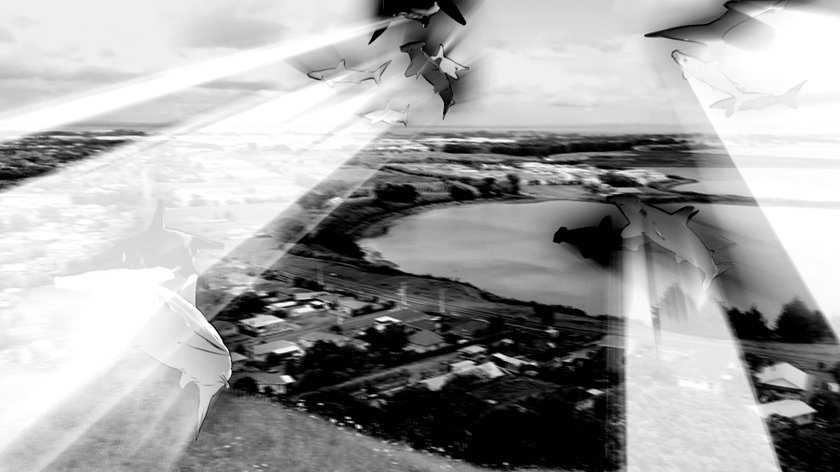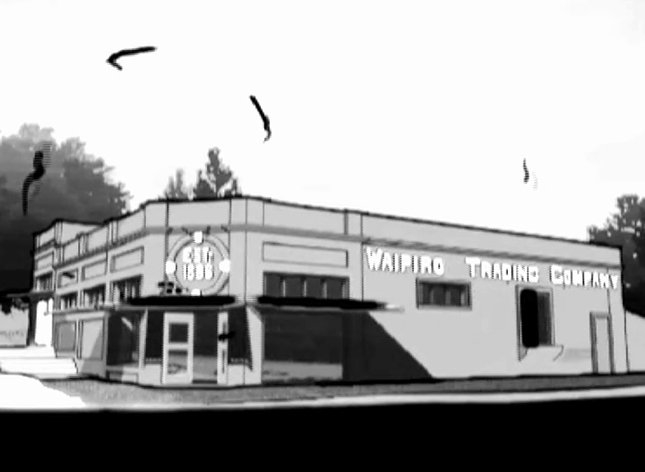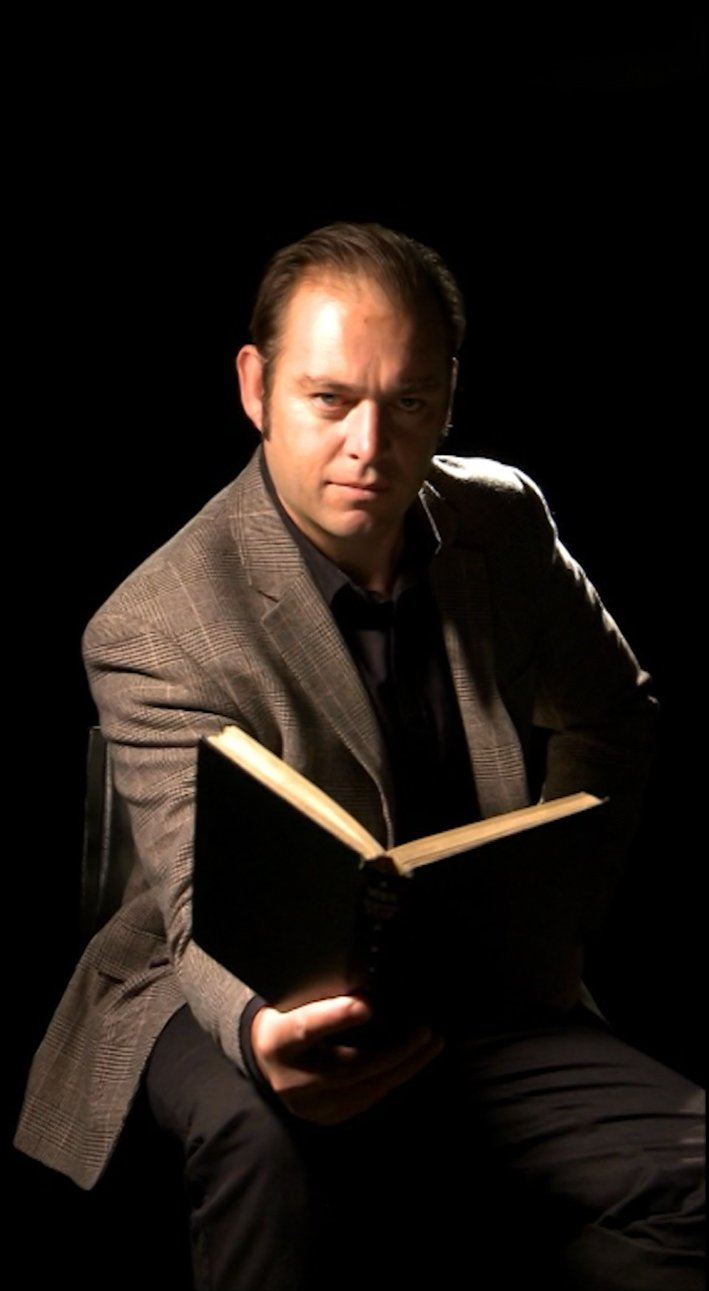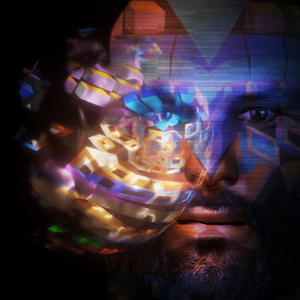Te Hiko Hou is an exhibition that combines electronic energies and constructed image making.
An arresting combination of digital media, film, video and animation, Te Hiko Hou features three male Māori artists; Rangituhia Hollis (Ngāti Porou, Ngāti Kahungunu), Shannon Te Ao (Ngāti Tuwharetoa) and Nathan Pohio (Kāti Mamoe, Kai Tahu and Waitaha).
Together, their works play on complex disjuncture or juxtapositions created between Māori communal lives and experiences of other "psychologically charged spaces." Individually, the artists in Te Hiko Hou reflect on "culture" in subtle, dissociated, familiar or quietly disturbing ways.
Rangituhia Hollis draws you into the darkened viewing space of the Film Archive mediagallery with the unsettling audio of his work Kei Mate Mangopare (2011). The science-fiction overtones of the soundtrack are matched by his expansive and compelling images. Combining live action and digital animation Hollis superimposes a fluid school of digitally enhanced sharks (including mangopare/hammerhead) who swim over a large vista of Manakau Harbour. It is a strangely disquieting and alienating light show.

Kei mate mangopare (2012) Rangituhia Hollis, courtesy of the artist
Curated by Jenny Gillam and Eugene Hansen, Te Hiko Hou (loosely translated as The New Electric) is one of four exhibitions presented by the pair as part of their 2012 curatorial residency at the New Zealand Film Archive, Wellington. If the curators' premise in Te Hiko Hou was to highlight ironic plays on what Māori male identity might be, I could not get away from the allusion of sharks and hammerheads in Hollis' work as indicators of tenacity, strength and temerity in battle over land.
Retaining land also maintains human connections and genealogies. Traditionally, these histories were recalled in customary Māori visual narratives, particularly in mangopare kowhaiwhai patterns located on painted heke or house rafters. Such images are localised, mnemonic devices drawing on events that then collapse time when relating them. Hollis however, is not overtly interested in this trans-customary relativity. Rather, his animated overlays tend to heighten disconnection from once intricate knowledge of place. When disassociation to environmental values within land and waterways happens, human disturbance manifests.
Hollis continues this disassociated theme in Waipiro Trading Company (2008) premised on a reconstructed Waipiro Trading Company building, established in 1886 but now abandoned at Waipiro Bay, East Coast.

Waipiro Trading Company (2008) Rangituhia Hollis, courtesy of the artist
Tuna kuwharuwharu (long fin eels) were an auspicious, natural resource for Tairawhiti, stretching south into Kahungunu country too. In this work, unease is manifested when animated eels are perpetually locked into a continuous loop of “migration” in and out of the building. Today, long fin tuna as a unique species indigenous to Aotearoa, face extinction from effects of long-term commercialization, over-exploitation of the resource, severe pollution of waterways by agriculture and blocked passages so they cannot migrate successfully. Hollis' work intimates that despite their once important roles as freshwater predators that balanced biodiversity in fresh waterways, long fin tuna are now abandoned to a cycle of disregard.
Shannon Te Ao adds to the general uneasiness of the combined works in Te Hiko Hou with Untitled (McCahon House study) (2011).
This video offered a series of intimate views into different male or androgynous personas. One screen featured a blue figure clad in a dressing-gown, whose facial features are at first hidden from the viewer. Another figure engaged in footwork with stones near a range slider, as if to generate some kind of threshold through which to pass over into another realm. Another squatted on a stack of concrete pavers, sounding out rhythms on the laundry sink or pressing down on a tied black Glad bag to expel leaves through the small aperture. Feet dragged the escaped leaves across another threshold to a damp deck where the mark making continued with intent, leading to the stripping of bright red fruit by hand from a nikau palm, within a lush Waitakare garden. Another vantage saw the performer scaling a ladder up a confined passage way.
I found Untitled (McCahon House study) perhaps the subtlest in intent and least accessible of Te Ao's work, perhaps due to this video work being obscure translations of site specific performances previously undertaken by the artist. Similarly, I could not quite equate the implied cosmological narratives of Untitled (McCahon House study) within the broader curatorial framework of Te Hiko Hou.
I related better to the next work Temporal Actions for New Arrivals (after Rakaihautu) (2012). A slightly harrowing experience for the artist, we follow his tracing of footfall over an estuary and witness his slapping, scraping, stabbing with a stick, raising and shaping of gravels, flicking of mud and haehae-like scarifications that he leaves in Waimea estuary, Whakatu (Nelson), when he walks out of frame.
, 2012 524.jpg)
Temporal actions for new arrivals, (after Rākaihautū) (2012) Shannon Te Ao collaborating with Iain Frengley. Courtesy of the artist
Such activities reference the process of art making in response to Te Ao learning more of the cultural significance of the Waimea area. In particular, he emulates the narrative of Māori chief and explorer Rakaihautu and how he first made landfall at the top of the south island at Nelson, and then travelled south “shaping and creating landscapes as he went.” In this work, Te Ao gets wet, muddy and in touch with conceptual riches to be found in local knowledge or allegory of place.
The equally compelling work of Nathan Pohio completes the trio.
Pohio has been practicing for a longer period of time than his fellow artists in the show and carries a significant body of work before him. I recall featuring a very early work of his in 1997, when I was studying contemporary Māori art and visual culture in the Toioho Ki Āpiti programme at Massey University, Palmerston North and in charge of an exhibition at the university. Pohio included a video image of Aorangi summit, a mauve mass against a light yellow ochre background on a now outmoded television screen, which he placed on the floor.
He has come a long way with Spyglass Field Recordings Vol 3: Notes towards assessing material from the universe and debriefing an agent of inner space (2011). This is a mature, accomplished and poignant work of “field recordings” or concentrated observations documented in journalistic style, which are then conveyed to the viewer in a careful and knowing manner. The stories reveal simple joys, emerging intimacies and even certain secrets to be kept close, when chronicling real-time conversations or “material from the universe”—to borrow the artist’s term. The viewer is then “debriefed” with a series of elaborate interrelationships witnessed and assessed by the artist.
Pohio's work was included in Unnerved: The New Zealand Project, a major Australian exhibition of contemporary New Zealand art. In Spyglass... Pohio notes various synchronicities and coincidences experienced when conversing with two different taxi drivers travelling to and from the airport.
This is the common denominator from which Pohio documents this travelling experience. He adopts the persona of debriefing agent, grand narrator emerging from and fading to black or even as kaitito pakiwaitara, a composer of stories.

Spyglass Field Recordings Vol.3: Notes towards accessing material from the universe and de-briefing an agent of inner space (2011) Nathan Pohio, courtesy of the artist
The curatorial premise of Te Hiko Hou explores and expands on notions of diversity and the individualized specifics of Māori male, identity politics. That’s all well and good, however whilst acknowledging and listing each artist’s genealogical links to eponymous ancestors and therefore valid tribal ties to various parts of the country, I could not help but equate each artist with this cultural anchor and view the work with an interchangeable lens. The curatorial starting points knowingly encourage a distance between communal and individualised experiences of Māori identity as constituting a nuanced rejection of stereotypical Māori males, and the artists involved engaged in “quiet activism.” However, the politics of Māori identity and what constitutes Māori males now is far more complex than what the curators let on. While not completely convinced by their set of vectors, I readily acknowledge that Te Hiko Hou is a compelling trip through the convoluted dynamic of identity politics on many levels and well worth the undertaking.
Dr Huhana Smith is currently working on a Pacific exhibition for the opening of the Humboldt-Forum, Berlin in 2019. She is former Senior Curator Māori (2003-2009) and is now a Research Associate at the Museum of New Zealand Te Papa Tongarewa. She is also currently Research Leader Māori for a major environmental research project for freshwater ways into the marine for a coastal area of Horowhenua, funded by Ministry of Science and Innovation. For this project she is also working with digital media experts developing new technologies and visual innovations that will ensure solutions for problems of ecological decline.
-2011.jpg)
